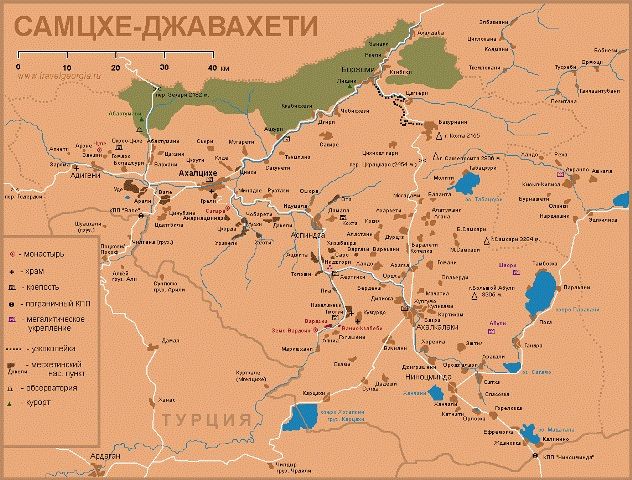At the beginning of XIX century one of the most important problems of the foreign policy of the Tsarist Russia was the occupation of the Caucasus.
The Tsarist Russia intended to put an end to the existence of the kingdom of Kartli-Kakhetia in order to strengthen its position in the basin of the Black Sea. Various plans were developed for it. Finally, the Czar of Kartli-Kakhetia accepted the protection of Russia on June 24, 1783, by signing the treaty of Georgiyevsky. Russia continued the invasion, conquered the Eastern Georgia in 1801. The first Armenian families begun to arrive there under the guidance of Lazarev, Armenian by origin..
Thus, 338 Armenian families (1906 people) in 1807-1808 were deported from around Tibilsi and from the district of Havlabar. In 1809-1811, 428 Armenian families (21- 40 people) were deported from Karabakh to Bolnisi. It must be mentioned General Lazarev played an active role in moving the Armenians here. At that time, several thousands of Armenians were deported to Shamshaddil (Loru) and Abkhazia from Iran and the Ottoman Empire. The social composition of the deported Armenians consisted of merchants and craftsmen. The Tsarist Russia thoroughly patronized the Armenian merchants, because Russia got raw materials of Asia through them, and took the Russian products to the markets of Iran and Turkey. Later the relations of Russia got strained with Iran and Turkey. By settling the Armenians in the territories bordering with these two states Russia was released from the payment of huge expenses for keeping the army for the protection of the state borders, because they could be protected by the “the Armenians who also had to supply the army with food and other necessaries. On November 4, 1827, General Paskevich sent his proposals to the headquarters of the Armed forces to move about 80.000 malorus Cossacks close to the Iranian borders. He tried to convince the government that the resettlement of the Cossacks was useful from every point of view. The settlements of the Cossacks military could protect the borders instead of regular armed forces. They would allow the use of the Russian traditions, lifestyle and administration among the local population, thus, the unification of these provinces with Russia would be possible. Thus, in 1828, the victory of the Tsarist Russia in the Russian-Turkish war raised the issue of resettlement of the military Cossacks to Samtskhe Chavakheti. But the migration of 80 thousands of malorus Cossacks created some economic and other difficulties. The Tsarist government refused this great plan. It began to move the Armenians to Trialet and Chavakheti from Turkey.
On December 3, 1829, a special deportation committee was set up by General Paskevich in order to carry out the deportation in conditions of complete security. The committee was headed by Governor Zavil, a civilian. The committee developed the regulations of the deportation. According to the first calculations of the Committee 8.000 Armenians had to be moved to Georgia from the provinces of Kars, Erzurum and Beyazit. But when the deportation began, the number of the families reached to 14.000. According to the well-known Georgian scholar Guram Markhulia, the rapid deportation of the Armenians to the areas determined in advance was the main priorities of the main cause of Russia in the Caucasus by which it wanted to change the ethnic composition of the region on the account of the Armenian migrants.
Thus, since the number of the Armenian population began to prevail the local Georgians in number. The tsarist Russia settled many Armenian families from Turkey together with the local population in Akhalkalak gubernia. Unlike the Armenians, the local population of Georgia lived in small glades and villages. As it is seen, the political aim of the tsarist Russia was to create an ethnically motley population in Georgia.
T.Jafarov
Uluturk.info











 Inauguration ceremony of President of Azerbaijan Ilham Aliyev was held
Inauguration ceremony of President of Azerbaijan Ilham Aliyev was held Ilham Aliyev wins presidential election with 92.05 percent of votes VIDEO
Ilham Aliyev wins presidential election with 92.05 percent of votes VIDEO President Ilham Aliyev, First Lady Mehriban Aliyeva and family members voted in Khankendi VIDEO
President Ilham Aliyev, First Lady Mehriban Aliyeva and family members voted in Khankendi VIDEO Plenary session of 6th Summit of Conference on Interaction and Confidence Building Measures in Asia gets underway in Astana. President Ilham Aliyev attends the plenary session VIDEO
Plenary session of 6th Summit of Conference on Interaction and Confidence Building Measures in Asia gets underway in Astana. President Ilham Aliyev attends the plenary session VIDEO President Ilham Aliyev was interviewed by Azerbaijani TV channels in Prague VIDEO
President Ilham Aliyev was interviewed by Azerbaijani TV channels in Prague VIDEO














